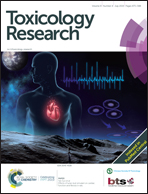Effects of lunar dust simulant on cardiac function and fibrosis in rats
Abstract
The objective of this study was to investigate the effects of lunar dust simulant (LDS) on cardiac function and fibrosis. In an in vivo experiment, after 3 weeks of exposure, electrocardiography (ECG) and histopathological and immunohistochemical analyses of the cardiac tissue were performed. Systemic inflammatory markers and genes and proteins associated with cardiac tissue fibrosis were examined. In an in vitro experiment, fibrosis-related factors were detected in H9c2 cells by western blot and the mechanism of myocardial fibrosis by LDS exposure was explored. LDS exposure significantly altered heart rate indicators, implying altered cardiac and autonomic system functions. LDS dose-dependently increased the type and number of ECG abnormalities, and increased serum inflammatory factors. In addition, pathological changes in the myocardial tissue were observed through hematoxylin and eosin, Masson, and immunohistochemical staining; the expression of genes and proteins related to fibrosis in the myocardial tissue was also altered. These findings indicate that LDS exposure causes systemic inflammatory lesions that affect autonomic function, leading to inflammatory myocardial fibrosis. And its mechanisms involve the mediation of the nuclear factor-E2-related factor (Nrf2)/nicotinamide adenine dinucleotide phosphate oxidase 4 (NOX4) redox balance.



 Please wait while we load your content...
Please wait while we load your content...